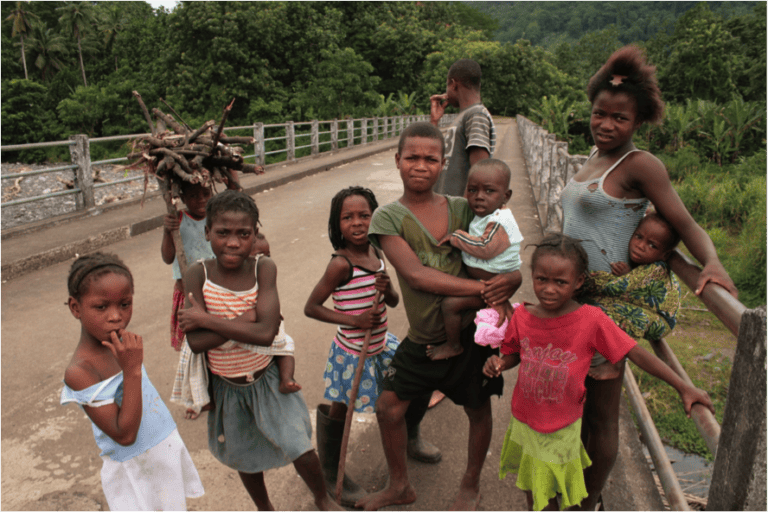- The Democratic Republic of São Tomé and Príncipe is the second-smallest country in Africa.
- Its avifauna includes at least 27 endemic species, while the famous Galapagos hold 21 in an area that is eight times larger.
- Human activities are threatening the unique biodiversity of the islands, and are likely to become more pressing in the nearby future, as the human population keeps growing.
Most people have never heard about the Democratic Republic of São Tomé and Príncipe. This island nation is the second-smallest in Africa, covering 1,001 square kilometers (about 386 square miles). Located in the Gulf of Guinea, right next to the equator, it is composed of the two main islands of São Tomé and Príncipe, as well as associated islets.
Despite its small size, these oceanic islands hold a remarkable wealth of biodiversity. Their forests have some of the highest concentrations of unique species worldwide and are surrounded by deep, rich seas, a fact attested to by the variety of cetaceans using their waters, the four species of sea turtles nesting on their beaches, and its large sea bird colonies.
Sometimes called the Galapagos of Africa, São Tomé and Príncipe do not fall short in the comparison. The avifauna of these two African islands hold a whopping 27 endemic species in an area that is eight times larger.

Historically, the biodiversity of these islands has received little attention by the scientific community, but a resurgence of interest has led to new species of vertebrates being described every year in recent times. Some examples include the Adamastor Skink (Trachylepis adamastor) and the Príncipe Shrew (Crocidura fingui), both described in 2015, as well as a new, undescribed Scops Owl confirmed in June 2016. One can only imagine how many species are left to find in species-rich groups that traditionally receive less attention, such as plants and insects.
Biodiversity haven at risk
Despite being little known, these remarkable islands are far from protected from human influence. Discovered by Portuguese navigators in the late 15th century, these islands have since then been the world’s largest producers of sugar cane and cocoa, and a large global producer of coffee. Human activities have had their toll on the unique biodiversity of the islands, and are likely to become more pressing in the near future, as the human population keeps growing.
As in many other places across the globe, habitat loss, overexploitation, and introduced species threaten the biodiversity of São Tomé and Príncipe. The rugged terrain has allowed native forests to remain standing in about one-quarter of the country. A similar area is covered by secondary forests, which, despite their reduced biodiversity value, are home to many of the endemics and act as a buffer, protecting the native forest from human influence.
However, there are strong indications that many of the islands’ resources are being exploited beyond sustainable levels, regardless of limited hard evidence. Key examples include logging and hunting.

The archipelago is located on the crossroads of Portuguese commercial trade routes, meaning that many species have been introduced to the islands throughout history, from all points of the globe. The distribution, ecology, and impact of this exotic fauna and flora have received little attention, but there is already some evidence that they might pose a critical long-term threat to the endemic species of São Tomé, namely by disrupting forest ecological networks.
As a result, many of São Tomé and Príncipe’s endemic species are listed as threatened by the IUCN. Among vertebrates, there are 18 threatened endemic species, and many more are likely to be listed soon, as new species are still being described and evaluated. Among other groups, such as plants and invertebrates, the task of identifying threatened taxa is even harder, since much of the taxonomy is not resolved and so little is known about most of those species.
Four bird species are listed as critically endangered: The Dwarf Olive Ibis (Bostrychia bocagei), the São Tomé fiscal (Lanius newtoni), the São Tomé Grosbeak (Neospiza concolor), and the Príncipe Thrush (Turdus xanthorhynchus). Restricted to the best-preserved forest areas, these birds have historically been little-studied. The grosbeak, for instance, had not been recorded for over 100 years and was even considered extinct until its rediscovery in 1991.
In recent years there has been more research on the islands, and recent findings even suggest that some of the critically endangered bird species might be less threatened than previously thought, despite ongoing and increasing threats. To raise awareness among Santomeans and gain local support for conservation, these species are now being promoted as symbols of forest conservation in the islands.

Conservation in São Tomé and Príncipe, and why it matters to us all
Since 2006, two protected areas have been established in the country: The São Tomé Obô Natural Park and the Príncipe Natural Park. These include the mountainous core of both islands, in total covering roughly one-third of the country. Besides constituting key areas for the conservation of biodiversity, the parks provide key services to the human populations of the islands, such as clean water and climate regulation.
In 2012, the whole island of Príncipe and surrounding waters and islets were classified as a Man and Biosphere Reserve by UNESCO — a classification that has helped promote sustainable development goals in the country’s smaller island.
These measures have contributed to a more hopeful future for the biodiversity and people of these unique islands. However, they have only been small steps in the right direction, at a time when unsustainable practices are creating new and harder conservation challenges every day.
Islands, due to their isolation, small size, and simpler systems, have long been used as models to develop some of the most revolutionary biological theories. The Galapagos, for instance, inspired Charles Darwin to develop the basis for modern evolutionary biology. At a time when the need for sustainable development is pressing at a global scale, small islands, like São Tomé and Príncipe, could also be used as models to find solutions at wider scales.